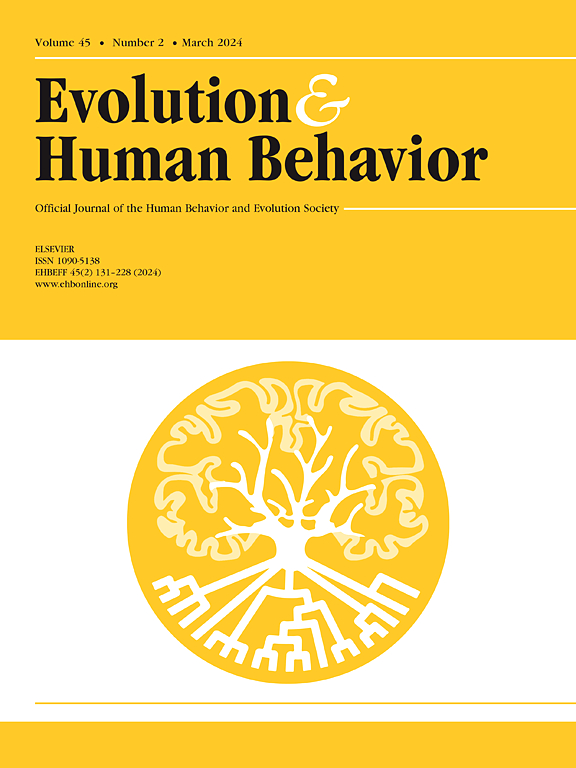Even small differences in attractiveness and formidability affect the probability and speed of selection: An online study and an offline replication
IF 3.2
1区 心理学
Q1 BEHAVIORAL SCIENCES
引用次数: 0
Abstract
Facial and bodily features represent salient visual stimuli upon which people spontaneously attribute various fitness-relevant characteristics such as attractiveness or formidability. While existing evidence predominantly relies on sequential stimuli presentation tasks, real-world social comparisons often involve assessing two or multiple individuals. In studies using two-alternative forced-choice tasks, participants usually perform at rates above the chance to select the expected option. However, these tasks use dichotomized and artificially manipulated stimuli that lack generalizability in situations where the differences between individuals are less likely to be ‘clear-cut’. We tested whether the probability of selection will proportionally increase with increasing degrees of difference between the stimuli or whether there is a discrimination threshold if the stimuli are perceived as too similar. In two registered studies comprising online (N = 446) and onsite (N = 56) participants, we explored the influence of the degree of difference in attractiveness and formidability ratings between stimuli pairs on both the probability of selection and selection speed. Participants were presented with randomly selected pairs of men (30 pairs of faces, 30 pairs of bodies) and tasked with choosing the more attractive or formidable target. Applying Bayesian inference, our findings reveal a systematic impact of the degree of difference on both the selection probability and speed. As differences in attractiveness or formidability increased, both men and women exhibited a heightened propensity and speed in selecting the higher-scoring stimuli. Our study demonstrates that people discriminate even slight differences in attractiveness and formidability, indicating that cognitive processes underlying the perception of these characteristics had undergone natural selection for a high level of discrimination.
即使吸引力和可塑造性的微小差异也会影响选择的概率和速度:在线研究和离线复制
面部和身体特征是一种显著的视觉刺激,人们会自发地将吸引力或可塑性等各种与适配性相关的特征归因于这些刺激。现有证据主要依赖于连续刺激呈现任务,而现实世界中的社会比较通常涉及对两个或多个个体进行评估。在使用双项强制选择任务的研究中,参与者的表现通常高于选择预期选项的几率。然而,这些任务使用的是二分法和人为操纵的刺激物,在个体间差异不太可能 "一目了然 "的情况下缺乏普遍性。我们测试了选择概率是否会随着刺激物之间差异程度的增加而成正比地增加,或者如果刺激物被认为过于相似,是否会存在一个分辨阈值。在由在线参与者(446 人)和现场参与者(56 人)组成的两项注册研究中,我们探讨了刺激对之间吸引力和可形成性评级的差异程度对选择概率和选择速度的影响。我们向受试者随机展示了一对男性刺激物(30 对脸部刺激物和 30 对身体刺激物),并要求受试者选择更具吸引力或更可怕的目标。通过贝叶斯推理,我们的研究结果表明,差异程度对选择概率和速度都有系统性的影响。随着吸引力或可塑造性差异的增加,男性和女性在选择得分较高的刺激物时都表现出更高的倾向和速度。我们的研究表明,即使吸引力和可塑性存在微小差异,人们也能分辨出来,这说明人们对这些特征的认知过程是经过自然选择的,具有较高的分辨能力。
本文章由计算机程序翻译,如有差异,请以英文原文为准。
求助全文
约1分钟内获得全文
求助全文
来源期刊

Evolution and Human Behavior
生物-行为科学
CiteScore
8.30
自引率
9.80%
发文量
62
审稿时长
82 days
期刊介绍:
Evolution and Human Behavior is an interdisciplinary journal, presenting research reports and theory in which evolutionary perspectives are brought to bear on the study of human behavior. It is primarily a scientific journal, but submissions from scholars in the humanities are also encouraged. Papers reporting on theoretical and empirical work on other species will be welcome if their relevance to the human animal is apparent.
 求助内容:
求助内容: 应助结果提醒方式:
应助结果提醒方式:


